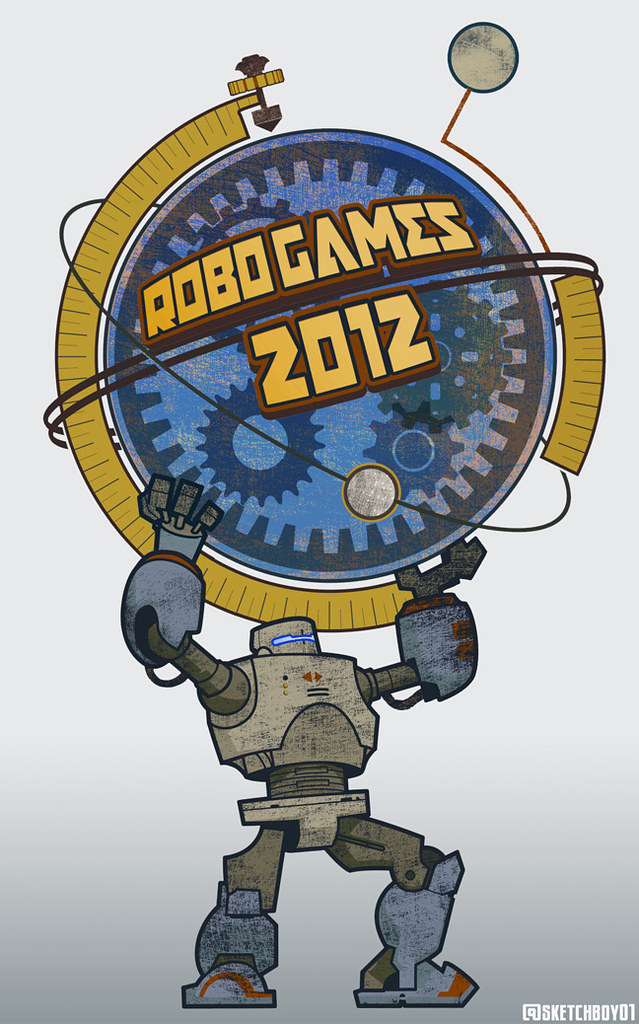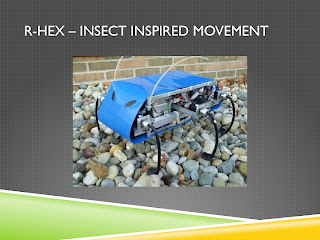Car grown from a seed (Concept car) http://www.youtube.com/watch?v=HX7pTHlLKiU
ROBOT GAMES: http://robogames.net/index.php

one of the MANY robot battles - this is of the M.I.T. crowd. Always a party
smallest Robot: "about 200 hundred of them could line up and do the conga across a plain M&M" - http://www.livescience.com/9346-worldatms-smallest-robot.html

What
is a robot? - Specifically a life like
one?
(One that looks like
us or something living, or something that acts like them.)
-
How do we
respond to them?
-
How are robots
similar and different than us?
-
What can they do
that we can’t?
Should Robots have feelings?
RADIOLAB: talking to machines
http://www.radiolab.org/2011/may/31/
ROBOT CONVENTION IN JAPAN
MDS ROBOTS = MOBILE, DEXTEROUS, SOCAIL ROBOT
Robots Mimicking nature:
Using an Exo-skeleton (*like an insect)
http://www.youtube.com/watch?v=twVZIwlhpKY
Fish robot
from the article: http://www.tecca.com/columns/lifesaving-robots/
5 cool robots that mimic animals to save lives
1. Recreating an octopus arm
The octopus is a truly amazing creature. Almost two-thirds of its neurons aren't located in its brain but are instead distributed throughout its body, including the tentacles (which means that each tentacle can operate independently). They're also incredibly agile, with an impressive ability to be both pliable and stiff. They can squeeze into all sorts of small and oddly shaped spaces while remaining capable of grabbing and retrieving objects.
It's these qualities that European scientists have recreated with the h: 0px; border-color: initial; border-left-width: 0px; border-right-width: 0px; border-style: initial; border-top-width: 0px; color: #1597d1; font-family: inherit; font-size: 14px; font-style: inherit; font-weight: inherit; margin-bottom: 0px; margin-left: 0px; margin-right: 0px; margin-top: 0px; outline-color: initial; outline-style: initial; outline-width: 0px; padding-bottom: 0px; padding-left: 0px; padding-right: 0px; padding-top: 0px; text-decoration: none; vertical-align: baseline;">robotic octopus armthat made its debut at the FET11 European Future Technologies Conference and Exhibitionearlier this year. Made of silicone-wrapped steel cable, the 17-inch arm has the grasping capabilities down, though scientists are still working on its pliability.
There are two goals with this area of research. One is to mimic the ability of octopus tentacles to get into oddly shaped areas while maintaining the ability to grasp and manipulate objects, an ability that would be incredibly useful for surgery, exploration, and rescue missions. The other goal is to understand how the octopus' complex neurological system functions and then apply that to robots used for medical and rescue operations.
2. Slug Crawler: Not pretty, but very useful
Slugs aren't exactly the most romantic of creatures, but the name is an apt description of this robot created by the Chiba Institute of Technology in Japan. The Slug Crawler Vehicle(SCV) was made to go where humans and most other robots can't. Its waterproof, dust-proof, flexible skin allows it to venture into all sorts of otherwise inaccessible locations.
The robot in this video is only a proof of concept; the Chiba Institute scientists plan to build a much larger version in the future. The planned creation will have a better camera system and be used in search and rescue operations to evaluate situations and locations too dangerous for humans.
3. Creepy spider robot
Another robot designed by Japanese scientists to help with search and rescue missions, the six-legged Asterisk comes from researchers at Osaka University. This somewhat creepy critter is capable of performing incredibly impressive stunts, from cartwheels to shimmying down webs.
The Asterisk's six-legged design also makes it very stable; it can support itself on three legs while using the other three to pick up and carry objects without compromising its stability. Scientists suggest that this will make it useful for both rescue and repair functions after disasters like last year's earthquake and tsunami in Japan.
4. AlphaDog goes anywhere and looks terrifying doing it
What's not to love about a huge, terrifying, vaguely dog-shaped robot lunging over hills and through forests? Designed to carry heavy loads over all sorts of terrain, DARPA's AlphaDog is just that.
Currently undergoing testing by the U.S. Marine Corps, AlphaDog can carry up to 400 pounds for 20 miles over the course of 24 hours without refueling. While it has numerous applications in the military realm, its potential use for bringing life-saving humanitarian supplies to remote locations is equally exciting.
5. A robotic jellyfish? Why not!
Real jellyfish are pretty cool, with their long tentacles and translucent bodies. Now researchers at the University of Texas at Dallas have taken nature one step further with the aptly named Robojelly, a high-tech robot that moves thanks to a series of chemical reactions.
Constructed from shape-changing smart materials and carbon nanotubes, the Robojelly is powered by heat-producing chemical reactions between oxygen and hydrogen taking place on its surface. The heat is then transferred to the robot's artificial muscles, where it's used to mimic a real jellyfish's movements. The biggest benefit of such a device is that it requires no internal fuel source such as batteries, which allows it to move without fear of losing power. Robojelly still has a lot of testing and development to undergo, but the results so far are pretty impressive. In the future it might be an asset to underwater search and rescue operations.
Robots and Nature: Fighting the good fight
Nature is pretty amazing, and it's interesting to watch humans struggle to mimic the actions that creatures great and small perform instinctively. By pulling the best and most useful capabilities from the natural world into the study of robotics, we'll be able to get into the toughest and most dangerous situations to safely bring back information, deliver supplies, and hopefully save lives.
[Image credit: DARPA]
Prosthetics:
Man with bionic filming eye:
Mercedes give teen a new bionic arm
http://www.youtube.com/watch?v=SIqAnrjqb0Y&feature=relmfu
Artificial Intelligence:
Artificial Intelligence: Thinking Big - KQED QUEST
MUSCLE WIRE VIDEOS:
Muscle wire inchworm http://youtu.be/k9f-W6Xi_Wo
Biology and Robots........ yes, "for real"
Robert Full on engineering and evolution
We are cyborgs ... now?
Amber Case: We are all cyborgs now
Flying robots
Vijay Kumar: Robots that fly ... and cooperate http://www.ted.com/talks/lang/en/vijay_kumar_robots_that_fly_and_cooperate.html
My 7 Species of Robot http://www.ted.com/talks/dennis_hong_my_seven_species_of_robot.html


































































































No comments:
Post a Comment